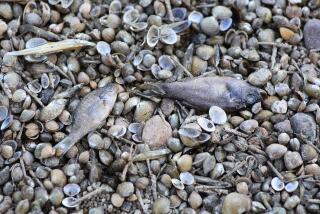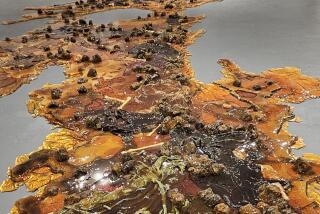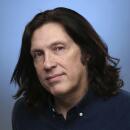River Artists Share Their Views of Waterway in Artspace Show : Exhibit: The collection features paintings, photographs, architectural drawings and installations, including historical perspectives.
- Share via
The images were very familiar last week, even here in these old photographs at the Artspace Gallery: sepia-toned scenes of Los Angeles suffering from rain and flood. In one picture from nearly a century ago, a mail carrier stands on a flooded city street; in another, a family and its belongings are crowded on a raft, drifting by half-submerged houses.
Those sorts of scenes were being played out again last week under heavy rains that flooded the Sepulveda Basin, sent water rushing down the Los Angeles River and claimed at least seven lives. It was all oddly coincidental timing for Artspace director Scott Canty, whose “A Look at the Los Angeles River” exhibit opened Tuesday at the Woodland Hills gallery.
The rains temporarily prevented some artists in the show from hanging their paintings and photographs and making some site-specific installations. Last weekend, the remaining works were installed.
The exhibition, Canty said, was designed chiefly as an educational study of the 54-mile river, which is often overlooked by the public as just “a trench, a concrete channel.” The natural waterway is now largely lined with concrete and incorporated into the city’s elaborate flood-control system, built over the last 65 years.
“It took about two years to make contacts” with artists and others for the show, said Canty, who curates the city’s three Municipal Satellite Galleries, including Artspace. “There’s a lot of artists and photographers that do things on the river, but you’ve got to go through a lot of people to find them. It’s not like they come out and say, ‘I’m a river artist.’ ”
Sharing wall space with 21 historical photographs culled from the Los Angeles Public Library archives is a variety of works concerned mainly with the river’s past and its possible future. Among the former are the lush panoramic photographs of Ford Lowcock and the romantic plein-air paintings of river bridges by Herbert A. Hazelton, an artist at the Hanna-Barbera animation studio.
Artist P. Allen Cocke’s installation work incorporates samples of river water pouring slowly over stained acrylic plastic etched with the names of various toxins found in the water. And video artist Cheri Gaulke joins teacher Susan Boyle and students from Wilson High School in a work that combines video images with actual debris found in the riverbed.
The show was originally planned for the city’s smaller Bridge Gallery downtown, Canty said. But it was soon decided to schedule the program at Artspace to allow room for multimedia presentations of such artists as Gaulke and others.
“The whole idea of an exhibition on the river lends itself to being very informative,” Canty said. “There’s no way around it. I guess you could just get the artists who do romantic versions of the river. But these artists get so involved in what’s happening in the political scene.”
To that end, a large section of the exhibit is devoted to architectural drawings and maps suggesting the future role of the Los Angeles River, which stretches from the Sepulveda Basin to Long Beach, traveling through 13 cities before arriving at the Queen Mary at the mouth of the channel. Included in the show are diagrams from the office of Assemblyman Richard Katz (D-Sylmar), who has proposed turning the concrete waterway into a roadway during dry periods.
The landscape architecture students of Takeo Ueugsi at Cal Poly Pomona have provided colorful drawings illustrating alternatives, including the creation of more surrounding parkland, which would also serve as reservoirs for use in future droughts.
Other suggestions in the drawings, which have been studied by the mayor’s Los Angeles River Task Force, include the creation of commercial riverfronts, bike paths and bird sanctuaries.
“If we just plant the edges of the channel with double rows of trees, from Sepulveda Basin to the ocean, the trees can consume the carbon dioxide emitted by a half-million people on a daily basis,” said Dilara El-Assaad, a landscape architect whose own six-year study of alternative uses for the river is part of the exhibition. “So that is a very simple start.
“With this latest flood, somehow there is an urgency that something should happen. We cannot sit and keep on delaying. We lost lives. I think this is ridiculous.”
Artist Janice DeLoof’s first significant contact with the river came in 1990 when she participated in a cleanup effort with Artists Contributing to the Solution and other groups. While there, she said, she discovered flocks of blue herons, among “many, many species of birds.”
“That opened me up to the fact that there was an L.A. River that had natural growth, and that the L.A. River could be beautiful,” DeLoof said.
Her contribution to the exhibit is a selection of photographs documenting that cleanup, surrounding a sculptural work that examines debate about the waterway’s future.
“We’re out of balance,” she said. “We need to get this stuff out on the table. Everyone thinks about their issue but doesn’t think about the whole city.”
DeLoof’s sculpture is an actual table whose surface is split into gray and green halves--representing nature and commerce--with newspaper articles about the river scattered across the top. And facing each other on the table are large carvings of a blue heron and a truck.
“I’m putting it all out on the table, visually, and hoping the citizen and the voter realize they have a role in this process,” she said. “We’re not just victims of special interests.”
Easily outnumbering other works in “A Look at the Los Angeles River” is the series of black-and-white photographs by Richard Risemberg and Beth Herzhaft. Both artists have traveled together down the channel, but capture different perspectives on their chosen subject.
Risemberg’s are often intimate vignettes of the area, from the small pockets of native wildlife to the temporary shelters of homeless people, whereas Herzhaft’s focus is usually on the communities that surround the river.
“When I first saw Richard’s work, back in 1986, he had gone down the river and photographed it,” Canty said. “And the pictures just intrigued me so much because some of them were so out of context with the city. It’s like he went up north and photographed these in a stream, when actually these were in Glendale, in the river.”
After the exhibition closes at the Artspace Gallery on March 28, Canty said, he hopes to see it travel to other galleries throughout Los Angeles and in cities adjacent to the river. Before the recent storms, he had expected the show to generate respectable, if moderate crowds.
But the coverage of the river in newspapers and on television has changed that. “I think as this exhibition moves on, it’s going to grow,” he said.
He said his only concern today is in avoiding the irony of a notice at the gallery reading: “Exhibit canceled due to the river flooding.”
“A Look at the Los Angeles River,” an exhibit of paintings, photographs, architectural drawings and installations, continues through March 28 at the Artspace Gallery, 21800 Oxnard St., Woodland Hills. Open noon to 5 p.m. Tuesdays through Saturdays. Free. Call (818) 716-2786.
More to Read
The biggest entertainment stories
Get our big stories about Hollywood, film, television, music, arts, culture and more right in your inbox as soon as they publish.
You may occasionally receive promotional content from the Los Angeles Times.











